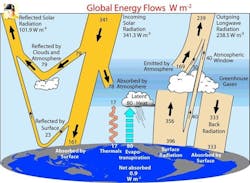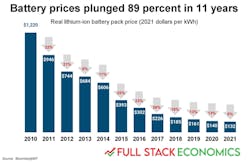Key takeaways:
- This article examines the realities of global warming and the self-regulating nature of Earth’s heat balance.
- It outlines actionable technologies—like electrolyzers and albedo enhancements—and argues that with political will and engineering innovation, a carbon-free future is still within reach.
For millions of years, humankind was mostly unable to convert or transport energy over long distances. Its fate changed with the discoveries of, first, the steam engine and later, electricity. Today, we can get energy by burning fossil fuels that were deposited underground, thousands of miles and years away.
During the industrial age, we nearly doubled the mass of the greenhouse gases (GTCO2e) in the air. During the industrial age, these gases blocked some 2,300-3,000 Q (Q =1015 BTU) of heat in the air, causing global warming. The U.S. National Centers for Environmental Information reported our planet sweltered as the global average temperature reached 17.01 °C (62.62 °F). But, the World Meteorological Organization’s latest State of the Global Climate reported 2024 was the hottest year since records started being kept 175 years ago (Figure 1).
Global warming is a somewhat self-regulating process because, while the buildup of greenhouse gases increases our global temperature, the increase in heat sent to outer space also reduces it. When global warming rises to the point where the two effects are equal, a new steady state is established. If this is so, it explains why the temperature of Earth never exceeded such a limit. Naturally, this steady-state temperature limit could exceed the temperature at which humans can survive, so we must stop global warming before that limit is reached.
I won’t make any predictions because I don’t have the data needed to calculate how much further inaction can be tolerated before our planet becomes unlivable. All I can say is the fact that the global warming process is self-regulating doesn’t mean that continued inaction is an acceptable option.
The main cause of global warming is the doubling of the carbon dioxide equivalent content in the air (Figure 2). Both global warming and pollutant concentration numbers are pretty bad, considering that they already exceed limits set by the 2015 Paris Agreement, which 195 nations agreed to use to limit their global warming to 1.5 °C, and in the worst case, prevent it from rising by more than 2 °C.
Yes, these numbers are bad, but are they irreversible? When people talk about 1.5 °C, what does it really mean? How do we measure global warming, and where did its gains and peak values originate? If the modeled global warming target goals can’t be kept, what can we do?
Who will give the answers to these questions? Will they be unbiased scientists or will they be people whose self-serving interests are selling natural gas or in getting re-elected? The continued inaction on climate change gives us the answer.
The heat balance process indicates that global average temperature rises if the heat entering the planet exceeds the amount leaving it. Global warming is a local phenomenon, which at Earth’s poles can be three or more times the global average. It can vary due to melting, evaporation, wind and ocean current directions, and can act as a heat conveyor that brings or removes heat from specific areas (Figure 2).
We live in the transition period
Some experts believe the first decade after the Paris Agreement was largely wasted, but was it? It seems this period of inaction was necessary to show us what the future could look like. It also serves to convince coming generations that we’re marching on a dead-end road.
Fighting economic or nuclear wars over the remaining resources won’t solve anything and could even trigger biblical-scale migrations from regions made unlivable by climate change. I believe that alarm clocks are buzzing, but I disagree that our collective response can only include sticking our collective heads in the sand. I believe that we will be smart enough to fix our problems by doing what it takes to end the fossil age and advance our energy economy into the safe, free and inexhaustible hydrogen age. I think there is hope and our engineers and scientists, including process control engineers, are up to the task.
Get your subscription to Control's tri-weekly newsletter.
Immediate steps required
In my past columns, I described the scientific and process control technologies already in use to fight climate change. Here are a few more that should also be used. These, in a few decades, can help us to complete the conversion to the coming carbon-free age.
We should agree that the main advance needed is direct financial support for the conversion because the influenceof the West’s fossil and military industries are still dominant. Most of the work on “green” advances happen in the East, not because of market forces, but because of politics. In the West, the oil lobby still rules the energy market, while China is way out in front on green energy despite an already favorable economic environment for green energy. For example, the costs of solar and wind electricity are already the lowest among all energy sources. The same is true for the costs of batteries and their raw materials (Figure 3). Another example of green advancement is the heat pump industry, which can barely keep up with demand for its products.
Naturally, the political environments can result in changes such as the elimination of solar subsidies. These events are only bumps on the road to our carbon-free future. Some of these still mostly unused methods can overcome such bumps by:
- Electrolyzers. The key bump on the road leading to the hydrogen age is the need to improve the electrolyzer, which generates electricity from water by using solar radiation to fuel the process. It does so by a process like photosynthesis, and is often referred to as the artificial tree. For hydrogen to become inexhaustible and clean fuel, technological advances and mass production are needed. My estimate of the size of this yearly investment is about $200 billion, which can be obtained by combining the development methods used to reduce battery costs (Figure 3) with carbon taxes.
- Albedo. Besides lowering the cost of electrolyzers, direct cooling should also be used to reduce global warming. This can be accomplished by lightening the human footprint on Earth by making its surface more reflective, which can be done relatively quickly and at a low cost by subsidizing conversion to using lighter colored materials. Today, the global albedo is about 30% and instead of rising, it’s dropping due to ocean-ice melting.
The hydrogen age
In our galaxy, life is only present where there is water. Water is both the fuel and the product of our energy cycle. Today, this balance is lost because stored fossils are also being burned. Once all fossils are burned, global warming will stop, but it probably will stop at a temperature that’s too high to support human life on most of our planet.
In this column, I focused on some reasons why I believe the Paris Agreement will survive, but I didn’t mention the most important one: I have five grandchildren and all of them are also working for Earth’s survival. Do I need to say more?
About the Author
Béla Lipták
Columnist and Control Consultant
Béla Lipták is an automation and safety consultant and editor of the Instrument and Automation Engineers’ Handbook (IAEH).

Leaders relevant to this article:




